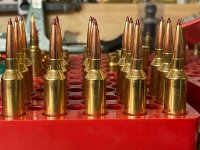By all means please enlighten me!
The part that seems obvious to me is that you've got "too many irons in the fire".
There are a number of things you didn't mention, that I don't know about, along with what you did say. First one is, do you have complete spec drawings of the .25 and 6.5mm cases? Are they exactly identical, or not??
Particularly the shoulders. Generally speaking, when you neck down the parent case to something smaller, it often changes the shoulder angle or length or both. is this what is happening here? The shoulders on the cases in your first pic, (fired .25 and new 6.5) look different to me. This could be the result of the camera angles and lighting, or are they actually measurably different??
You are sizing in the parent case die, (6.5) and then using a "work around" a collet to size the neck, which obviously works, but isn't the same as a properly cut die for the .25 round.
Next point is that, while that method is producing functioning ammo, what is the relationship between the ammo made that way and how your chamber is actually cut.
You've set the headspace twice (so far) and still have issues. It may be that your problems are the result of "stacking tolerances" because you have stacked so many things upon each other.
This is not meant as any kind of criticism, but as a possible explanation of what is going on, based on what you posted.
I think you've got so much going on you can't really tell for sure which thing is causing what.
From what I can see there is a likely solution, but its not even remotely cheap. There's no such thing as "can't get a die for..." there's only "can't get a die for .... at a price I'm willing to pay".
A custom cut die, made to match your rifle's chamber isn't cheap, but does offer the best chance for bughole accuracy and long case life. It is not impossible you could tinker with everything and not get the results that make you happy, without it. I hope you can, but do consider that when you've tried everything that should work, but doesn't, it might be time to consider a different approach.


